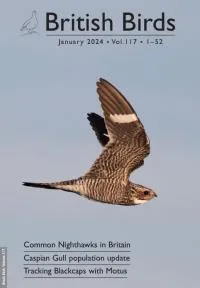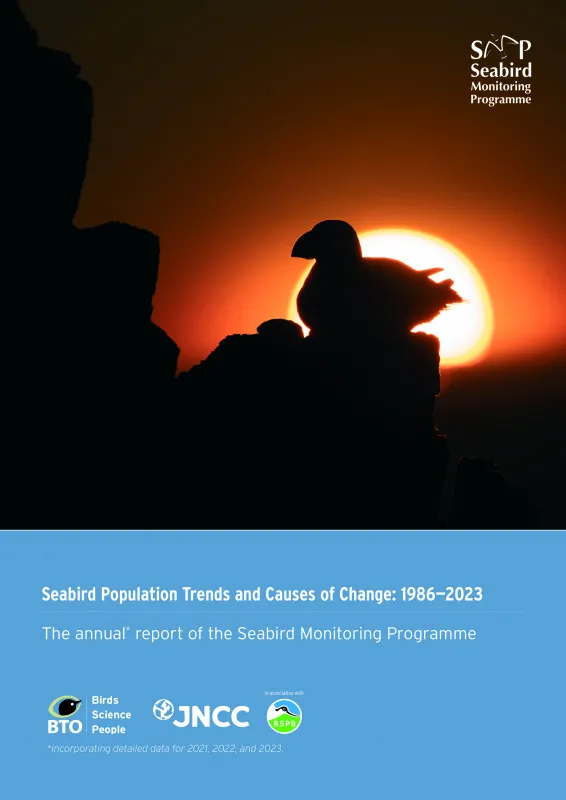Razorbill

Introduction
This striking bird, with its neat black and white breeding plumage, breeds in colonies alongside Guillemots and other seabirds.
Although the Razorbill shares a generally similar breeding distribution to Guillemot, absent only from those stretches of coast that lack suitable nesting cliffs, it has less exacting nest site preferences and occupies a slightly larger coastal range. Despite this, our Razorbill population is significantly smaller than that of Guillemot.
A significant proportion of the Razorbill population breeds here in Britain & Ireland, making our shores important in a global context.

Key Stats
Identification
ID Videos
This section features BTO training videos headlining this species, or featuring it as a potential confusion species.
Winter Auks
Songs and Calls
Song:
Status and Trends
Conservation Status
Population Change
The UK population increased by 40% between 1969–70 and Seabird 2000 (1998–2002). Annual counts from the Seabird Monitoring Programme suggest that numbers may have increased further since Seabird 2000, despite a shallow decrease during the first decade of the 21st century, although there are wide confidence intervals around these trends; data from the more recent Seabirds Count (2015–2021) should help confirm the recent trend once they are available (JNCC 2022).
Distribution
Razorbills are largely pelagic in winter, yet were still reported around most of the coast of Britain & Ireland during Bird Atlas 2007–11. The breeding-season distribution is similar to that of the Guillemot, with breeding birds absent between Yorkshire and Dorset, where there is no suitable nesting habitat. The largest concentrations are from Flamborough Head to the Northern Isles and at many locations up the western seaboard of both Britain and Ireland.
Occupied 10-km squares in UK
or view it on Bird Atlas Mapstore.
or view it on Bird Atlas Mapstore.
European Distribution Map
Distribution Change
Change in occupied 10-km squares in the UK
or view it on Bird Atlas Mapstore.
or view it on Bird Atlas Mapstore.
Seasonality
Razorbills are recorded throughout the year, though more consistently during summer at suitable coastal breeding sites.
Weekly pattern of occurrence
The graph shows when the species is present in the UK, with taller bars indicating a higher likelihood of encountering the species in appropriate regions and habitats.

Movement
Britain & Ireland movement
Foreign locations of birds ringed or recovered in Britain & Ireland
Dots show the foreign destinations of birds ringed in Britain & Ireland, and the origins of birds ringed overseas that were subsequently recaptured, resighted or found dead in Britain & Ireland. Dot colours indicate the time of year that the species was present at the location.
- Winter (Nov-Feb)
- Spring (Mar-Apr)
- Summer (May-Jul)
- Autumn (Aug-Oct)

European movements
EuroBirdPortal uses birdwatcher's records, such as those logged in BirdTrack to map the flows of birds as they arrive and depart Europe. See maps for this species here.
The Eurasian-African Migration Atlas shows movements of individual birds ringed or recovered in Europe. See maps for this species here.
Biology
Productivity and Nesting
Nesting timing
Egg measurements
Clutch Size
Survival and Longevity
Survival is shown as the proportion of birds surviving from one year to the next and is derived from bird ringing data. It can also be used to estimate how long birds typically live.
View number ringed each year in the Online Ringing Report.
lifespan
Survival of adults
Survival of juveniles
Biometrics
Wing length and body weights are from live birds (source).
Wing length
Body weight
Ring Size
Classification, names and codes
Classification and Codes
- Order: Charadriiformes
- Family: Alcidae
- Scientific name: Alca torda
- Authority: Linnaeus, 1758
- BTO 2-letter code: RA
- BTO 5-letter code: RAZOR
- Euring code number: 6360
Alternate species names
- Catalan: gavot
- Czech: alka malá
- Danish: Alk
- Dutch: Alk
- Estonian: alk
- Finnish: ruokki
- French: Petit Pingouin
- Gaelic: Coltraiche
- German: Tordalk
- Hungarian: alka
- Icelandic: Álka
- Irish: Crosán
- Italian: Gazza marina
- Latvian: lielais alks
- Lithuanian: alka
- Norwegian: Alke
- Polish: alka (zwyczajna)
- Portuguese: torda-mergulheira
- Slovak: alka vrúbkozobá
- Slovenian: njorka
- Spanish: Alca común
- Swedish: tordmule
- Welsh: Llurs
- English folkname(s): Scout, Willock
Research
Causes of Change and Solutions
Causes of change
Although the UK population of Razorbills show an increasing trend, there are concerns about very low breeding productivity, particularly during the first decade of the 21st century. Low productivity is believed to be linked to food supplies, particularly of sandeels Ammodtyes marinus, which may be linked to sea surface temperatures and hence climate change. As Razorbills typically live for 13 years and can live for up to 40 years, low productivity is an early warning sign which can be expected to lead to population declines over the medium- to long-term, provided other factors such as survival remain constant.
Publications (2)
The status of the UK’s breeding seabirds
Author: Stanbury, A.J., Burns, F., Aebischer, N.J., Baker, H., Balmer, D., Brown, A.F., Dunn, T., Lindley, P., Murphy, M., Noble, D.G., Owens, R. & Quinn, L.
Published: 2024
Five seabird species are added to the Birds of Conservation Concern Red List in this addendum to the 2021 update, bringing the total number of Red-listed seabird species to 10, up from six since seabirds were last assessed. The Amber List of seabirds moves from 19 to 14 species, and the Green List increases from one to two species.
29.09.24
Papers

Seabird Population Trends and Causes of Change: 1986–2023
Author: Harris, S.J., Baker, H., Balmer, D.E., Bolton, M., Burton, N.H.K., Caulfield, E., Clarke, J.A.E., Dunn, T.E., Evans, T.J., Hereward, H.R.F., Humphreys, E.M., Money, S. and O’Hanlon, N.J.
Published: 2024
This report presents the latest seabird population trends in breeding abundance and productivity using data from the Seabird Monitoring Programme (SMP).The report documents changes in the abundance and productivity of breeding seabird species in Britain and Ireland from 1986 to 2023, and provides a detailed account of the 2021, 2022 and 2023 breeding seasons.This report includes both inland and coastal populations and trends from the Channel Islands, England, Isle of Man, Northern Ireland, Scotland, Wales and the Republic of Ireland, which are presented where sufficient data are available. The results from this report are used more broadly to assess the health of the wider environment, to inform policy and for conservation action.
21.11.24
Reports Research reports


